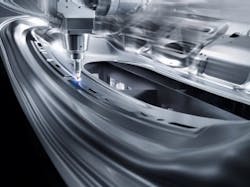TRUMPF opens Berlin subsidiary for high-efficiency laser diode development
On October 1, 2015, industrial laser manufacturer TRUMPF (Ditzingen, Germany) will open a new subsidiary for the advance engineering of laser diodes in Berlin. In close proximity, and also in Berlin, are the two German research institutes Ferdinand-Braun-Institut (FBH) and Leibniz-Institut für Höchstfrequenztechnik, which TRUMPF closely cooperates with in developing new laser technology.
TRUMPF's new subsidiary will be developing energy-efficient laser diodes both as laser pump sources and as light sources for direct diode lasers, in which light from many high-power laser-diodes is efficiently coupled into optical fibers, with the goal of maintaining as low a beam parameter product (BPP) as possible, which equates to having as high a brightness as possible. The resulting beam, one the order of 0.1 mm in diameter, can then be used to cut metals such as steel in the automotive and shipbuilding industries.
TRUMPF already has extensive experience creating high-power laser-diode arrays as pumps for the company's disk lasers.
Initial staff of ten people
"The Berlin subsidiary, with its initial staff of ten people and the joint ventures emanating from it, is of crucial importance for our development work on this key future topic," says Berthold Schmidt, head of the central department for Research and Development at TRUMPF. "We're attempting to look ten years ahead here, and to lay the foundations for future applications." Professor Günther Tränkle, Director of the FBH, adds, "We're looking forward to cooperate directly with TRUMPF in the active Berlin research landscape. The joint venture underlines the capability of our FBH teams, as well as the desire, even of major players, to maintain and further extend their market lead with our assistance."
TRUMPF and the FBH have already worked together for several years now on brilliant high-power diode lasers. TRUMPF also funds several PhD studentships at the FBH. "Over the past years our research activities have resulted in numerous patents, enabling further improvements to diode lasers," says Tränkle. "The demand is there and will continue to grow, because the market for laser systems that can process and cut metals is vast." For some materials, such as the tempered steel used in the manufacture of monocoque safety cells in automobiles, the laser is virtually unrivaled, and has long since become an indispensable tool in production.
Stephan Strohmaier, who runs the TRUMPF subsidiary in Berlin, adds, "For cutting thick sheet metal, a very powerful laser beam is required. Our goal is to efficiently combine ever more laser power inside an ever more brilliant beam -- and we're getting better at it all the time." In terms of power density and power-to-light conversion rate, diode lasers from FBH and TRUMPF are currently among the most powerful in the world, and new records are constantly being set in the laboratories. The Berlin TRUMPF subsidiary -- which is not only well positioned in the fields of semiconductor laser physics, mounting technology, design, and simulation but also has its own clean room facilities – will be driving the development further.
TRUMPF is improving the energy efficiency of its laser systems to enable "green" production for its customers. Diode-pumped solid-state lasers and direct-diode lasers, with efficiencies of 30% to 40% and higher, are pointing the way, says the company.
Source: AlphaGalileo
About the Author
John Wallace
Senior Technical Editor (1998-2022)
John Wallace was with Laser Focus World for nearly 25 years, retiring in late June 2022. He obtained a bachelor's degree in mechanical engineering and physics at Rutgers University and a master's in optical engineering at the University of Rochester. Before becoming an editor, John worked as an engineer at RCA, Exxon, Eastman Kodak, and GCA Corporation.

